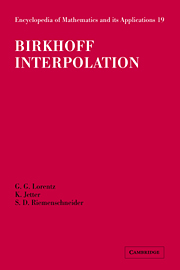Book contents
- Frontmatter
- Contents
- Editor's Statement
- Preface
- Introduction
- Chapter 1 Basic Definitions and Properties
- Chapter 2 Further Elementary Theorems
- Chapter 3 Coalescence of Rows
- Chapter 4 Applications of Coalescence
- Chapter 5 Rolle Extensions and Independent Sets of Knots
- Chapter 6 Singular Matrices
- Chapter 7 Zeros of Birkhoff Splines
- Chapter 8 Almost-Hermitian Matrices; Special Three-Row Matrices
- Chapter 9 Applications
- Chapter 10 Birkhoff Quadrature Formulas
- Chapter 11 Interpolation at the Roots of Unity
- Chapter 12 Turán's Problem of (0, 2) Interpolation
- Chapter 13 Birkhoff Interpolation by Splines
- Chapter 14 Regularity Theorems and Self-Dual Problems
- Bibliography and References
- Symbol Index
- Subject Index
Chapter 14 - Regularity Theorems and Self-Dual Problems
Published online by Cambridge University Press: 05 April 2013
- Frontmatter
- Contents
- Editor's Statement
- Preface
- Introduction
- Chapter 1 Basic Definitions and Properties
- Chapter 2 Further Elementary Theorems
- Chapter 3 Coalescence of Rows
- Chapter 4 Applications of Coalescence
- Chapter 5 Rolle Extensions and Independent Sets of Knots
- Chapter 6 Singular Matrices
- Chapter 7 Zeros of Birkhoff Splines
- Chapter 8 Almost-Hermitian Matrices; Special Three-Row Matrices
- Chapter 9 Applications
- Chapter 10 Birkhoff Quadrature Formulas
- Chapter 11 Interpolation at the Roots of Unity
- Chapter 12 Turán's Problem of (0, 2) Interpolation
- Chapter 13 Birkhoff Interpolation by Splines
- Chapter 14 Regularity Theorems and Self-Dual Problems
- Bibliography and References
- Symbol Index
- Subject Index
Summary
HISTORICAL REMARKS
The first papers containing regularity results for spline interpolation were [155, 74, 64]. Their characteristic features are similar: The interlacing conditions (13.1.5) are necessary and sufficient for regularity; the proof is based on the total positivity of certain matrices. This approach gives much more than regularity, and this is perhaps the reason why no stronger regularity results have been achieved this way. The strongest theorem (regularity when E, E* are quasi-Hermitian) is stated in Karlin [64, 66].
The next important step was achieved by Melkman [120]; he established the regularity when E is conservative, E* Lagrangian, and announced that he also had a proof when E* is Hermitian. This was soon established by Jetter [57], who sketched a proof relying on Theorem 7.13 of Birkhoff and Lorentz. Pence [134] somewhat improved Melkman's conditions. Like Melkman, Goodman [47] also relied on Budan–Fourier theorems to derive his remarkable theorem.
The use of Rolle's theorem for splines (Lemma 7.10) was inaugurated by Lorentz [93]; de Boor [B, 10] used the ordinary Rolle theorem to derive theorems of [155] and [74]. In §14.2 we give a general theorem [61] that uses diagrams of splines, from which the theorem of Goodman follows easily (by means of a relatively simple Lemma 14.5).
Several methods of proof of regularity theorems are known. In this chapter we illustrate: an application of the zero count theorem in this section, of Rolle's lemmas in §§14.2–14.3, and a completely different, more elementary approach that works for self-dual interpolation problems in §14.4. The reader can consult in [47] the original proof of theorem 14.4, based on the classical Budan–Fourier Theorem 2.2.
Information
- Type
- Chapter
- Information
- Birkhoff Interpolation , pp. 203 - 219Publisher: Cambridge University PressPrint publication year: 1984
